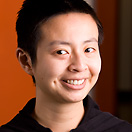Close Up
Conjoined twins focus of book
-
 Print
Print -
 Comments
Comments
-

“What I’m finding is that there’s a remarkable level of consistency with which these famous figures are cast as metaphors for nation and citizenship at key moments in American history, especially when national unity is most threatened.”
Cynthia Wu says she got the inspiration for her current book project from an unusual source—the autobiography of circus founder and entertainment entrepreneur P.T. Barnum.
Perhaps unsurprisingly, says Wu, who joined the Department of American Studies as an assistant professor this fall, the man who is said to have coined the phrase “There’s a sucker born every minute” seemed all too eager to keep himself in the center ring, pushing everyone else in his story out of the spotlight.
“It’s a very tedious autobiography to read because it’s so self-congratulatory,” says Wu, whose interests include Asian American studies, disability studies and queer theory. “But then I started thinking about all these employees he had written about and began to wonder: Might there be another side to this story other than these employees being these peons to this self-aggrandizing man? Might they have their own tale to tell?”
That led her to Chang and Eng Bunker, “the original Siamese Twins,” who were brought to the United States as indentured servants by a British merchant in 1829.
The brothers continue to fascinate more than 130 years after their death, she says, not only because of their unusual physical characteristics, but also their unique place in American culture. From humble origins in a traveling freak show, Chang and Eng went on to manage their own careers, purchase a Southern tobacco plantation, own slaves, marry two traditional “Southern belles” and have sons who fought for the Confederacy during the Civil War.
“My project looks at the ways in which Chang and Eng get portrayed in American arts and culture,” says Wu. “What I’m finding is that there’s a remarkable level of consistency with which these famous figures are cast as metaphors for nation and citizenship at key moments in American history, especially when national unity is most threatened.”
For example, she says Mark Twain placed Chang and Eng in “Personal Habits of the Siamese Twins,” a humorous tale in which the twins are portrayed as representing the former Union and Confederate states. The prominent 19th-century political cartoonist Thomas Nast also used the image of conjoined twins—one a factory owner, one a worker—to argue against union organization, as each requires the other for survival.
The duo turns up in modern works as well, including “Dead Ringers,” a film by David Cronenberg; “God’s Fool,” a novel by Mark Slouka; and “Tripmaster Monkey,” a novel by Maxine Hong Kingston. In addition, Asian American novelist Monica Sone and graphic novelist Judy Han use conjoined twins as a metaphor for the cultural conflicts felt by the children of Asian immigrants.
“The twin’s racial difference, and also their anatomical difference, gets mobilized again and again in these narratives of national unity and progress,” says Wu, noting that the “central question” of being part of the United States is how to balance the rights of the individuals with the need to act as a group.
Although hired as a specialist in Asian American studies, Wu says her approach to the field examines the ways in which the histories of all racial and ethnic groups are intertwined. For instance, she notes that the first Asian immigrants in the U.S. were brought to the country as cheap labor to undermine the organizing efforts of Irish immigrants. She also points out that after these Asian immigrants left California, many settled in the South, opening businesses that directly competed with those owned by recently emancipated African Americans.
The recipient of master’s and doctoral degrees from the University of Michigan-Ann Arbor—as well as a bachelor’s degree from Bryn Mawr College—Wu says she came to UB for the chance to pursue more research and mentor graduate students. She previously was an assistant professor at Agnes Scott College, a private, liberal arts women’s college in Decatur, Ga., and a visiting assistant professor at Macalester College, a small private college in St. Paul, Minn.
“When I think about the research interests of every single one of my [UB] colleagues, it seems like all of them have something to inspire me with,” says Wu. “I feel like this is really the place that I was meant to be.”

Reader Comments